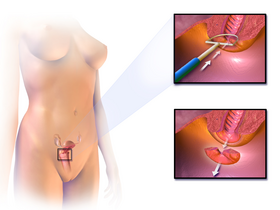| Loop electrical excision procedure | |
|---|---|
 | |
| Other names | Large loop excision of the transformation zone |
| Specialty | Gynaecology |
The loop electrosurgical excision procedure (LEEP) is one of the most commonly used approaches to treat high grade cervical dysplasia (CIN II/III, HGSIL) and early stage cervical cancer discovered on colposcopic examination. In the UK, it is known as large loop excision of the transformation zone (LLETZ). It is considered a type of conization.[1] It has been in use since the 1970s, after its invention by Dr. Sheldon Weinstein. [2]
LEEP has many advantages including low cost and a high success rate.[3] The procedure can be done in an office setting and usually only requires a local anesthetic, though sometimes IV sedation or a general anesthetic is used.[4] Disadvantages include reports of decreased sexual satisfaction [5] and potential for preterm labor, though a meta-analysis published in 2014 suggested that in patients with existing CIN lesions as opposed to controls, the risk is not more than their baseline risk.[6] Approximately 500,000 LEEP procedures are performed in the U.S. annually. [7]
- ^ Pflugner, Lindsey (2024-03-21). "Loop Electrosurgical Excision Procedure (LEEP): Background, Indications, Procedure". Medscape Reference. Retrieved 2024-08-08.
- ^ "Loop Electrosurgical Excision Procedure (LEEP) | Embryo Project Encyclopedia". embryo.asu.edu. Retrieved 2023-11-16.
- ^ "Loop electrosurgical excision procedure (LEEP) for abnormal cervical cell changes". Retrieved 2016-11-27.
- ^ Mayeaux, E.J. Jr. "Advantages of LEEP". Archived from the original on 2006-09-04. Retrieved 2007-12-28.
- ^ Inna, Namfon; Phianmongkhol, Yupin; Charoenkwan, Kittipat (1 March 2010). "Sexual function after loop electrosurgical excision procedure for cervical dysplasia". J Sex Med. 7 (3): 1291–1297. doi:10.1111/j.1743-6109.2009.01633.x. PMID 19968775.
- ^ Conner SN, Frey HA, Cahill AG, Macones GA, Colditz GA, Tuuli MG (April 2014). "Loop electrosurgical excision procedure and risk of preterm birth: a systematic review and meta-analysis". Obstetrics and Gynecology. 123 (4): 752–61. doi:10.1097/AOG.0000000000000174. PMC 4113318. PMID 24785601.
- ^ Sklavos, Martha M.; Spracklen, Cassandra N.; Saftlas, Audrey F.; Pinto, Ligia A. (2014). "Does Loop Electrosurgical Excision Procedure of the Uterine Cervix Affect Anti-Müllerian Hormone Levels?". BioMed Research International. 2014: 875438. doi:10.1155/2014/875438. ISSN 2314-6133. PMC 3953513. PMID 24707500.